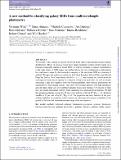Files in this item
A new method for classifying galaxy SEDs from multiwavelength photometry
Item metadata
| dc.contributor.author | Wild, Vivienne | |
| dc.contributor.author | Almaini, Omar | |
| dc.contributor.author | Cirasuolo, Michele | |
| dc.contributor.author | Dunlop, Jim | |
| dc.contributor.author | McLure, Ross | |
| dc.contributor.author | Bowler, Rebecca | |
| dc.contributor.author | Ferreira, Joao | |
| dc.contributor.author | Bradshaw, Emma | |
| dc.contributor.author | Chuter, Robert | |
| dc.contributor.author | Hartley, Will | |
| dc.date.accessioned | 2014-09-09T09:01:03Z | |
| dc.date.available | 2014-09-09T09:01:03Z | |
| dc.date.issued | 2014-05-11 | |
| dc.identifier | 119001540 | |
| dc.identifier | 3cc45af6-2ef5-499a-afae-2f9d44edbe28 | |
| dc.identifier | 84898971599 | |
| dc.identifier | 000334742200070 | |
| dc.identifier.citation | Wild , V , Almaini , O , Cirasuolo , M , Dunlop , J , McLure , R , Bowler , R , Ferreira , J , Bradshaw , E , Chuter , R & Hartley , W 2014 , ' A new method for classifying galaxy SEDs from multiwavelength photometry ' , Monthly Notices of the Royal Astronomical Society , vol. 440 , no. 2 , pp. 1880-1898 . https://doi.org/10.1093/mnras/stu212 | en |
| dc.identifier.issn | 0035-8711 | |
| dc.identifier.other | BibCode: 2014MNRAS.440.1880W | |
| dc.identifier.uri | https://hdl.handle.net/10023/5379 | |
| dc.description | VW acknowledges support from the European Research Council Starting Grant (PI: V. Wild), European Research Council Advanced Grant (PI: J. Dunlop) and European Career Re-integration Grant (PI: V. Wild). JSD acknowledges support from the European Research Council Advanced Grant (PI: J. Dunlop). RM acknowledges support from the European Research Council Consolidator Grant (PI: R. McLure). JSD also acknowledges the contribution of the EC FP7 SPACE project ASTRODEEP (Ref. No: 312725). This work was supported in part by the National Science Foundation under Grant No. PHYS-1066293. | en |
| dc.description.abstract | We present a new method to classify the broad-band optical–near-infrared spectral energy distributions (SEDs) of galaxies using three shape parameters (super-colours) based on a principal component analysis of model SEDs. As well as providing a compact representation of the wide variety of SED shapes, the method allows for easy visualization of information loss and biases caused by the incomplete sampling of the rest-frame SED as a function of redshift. We apply the method to galaxies in the United Kingdom Infrared Telescope Infrared Deep Sky Survey Ultra Deep Survey with 0.9 < z < 1.2, and confirm our classifications by stacking rest-frame optical spectra for a fraction of objects in each class. As well as cleanly separating a tight red sequence from star-forming galaxies, three unusual populations are identifiable by their unique colours: very dusty star-forming galaxies with high metallicity and old mean stellar age; post-starburst galaxies which have formed ≳10 per cent of their mass in a recent unsustained starburst event; and metal-poor quiescent dwarf galaxies. We find that quiescent galaxies account for 45 per cent of galaxies with log M*/M⊙ > 11, declining steadily to 13 per cent at log M*/M⊙ = 10. The properties and mass function of the post-starburst galaxies are consistent with a scenario in which gas-rich mergers contribute to the growth of the low- and intermediate-mass range of the red sequence. | |
| dc.format.extent | 19 | |
| dc.format.extent | 11515383 | |
| dc.language.iso | eng | |
| dc.relation.ispartof | Monthly Notices of the Royal Astronomical Society | en |
| dc.subject | Methods: statistical | en |
| dc.subject | Galaxies: fundamental parameters | en |
| dc.subject | Galaxies: luminosity function | en |
| dc.subject | Mass function | en |
| dc.subject | Galaxies: photometry | en |
| dc.subject | Galaxies: statistics | en |
| dc.subject | Galaxies: stellar content | en |
| dc.subject | QB Astronomy | en |
| dc.subject | QC Physics | en |
| dc.subject | BDC | en |
| dc.subject | R2C | en |
| dc.subject.lcc | QB | en |
| dc.subject.lcc | QC | en |
| dc.title | A new method for classifying galaxy SEDs from multiwavelength photometry | en |
| dc.type | Journal article | en |
| dc.contributor.sponsor | European Research Council | en |
| dc.contributor.institution | University of St Andrews. School of Physics and Astronomy | en |
| dc.identifier.doi | 10.1093/mnras/stu212 | |
| dc.description.status | Peer reviewed | en |
| dc.identifier.url | https://academic.oup.com/mnras/article/440/2/1880/1020809#92775470 | en |
| dc.identifier.grantnumber | ERC-2012-StG-20111012 | en |
This item appears in the following Collection(s)
Items in the St Andrews Research Repository are protected by copyright, with all rights reserved, unless otherwise indicated.

